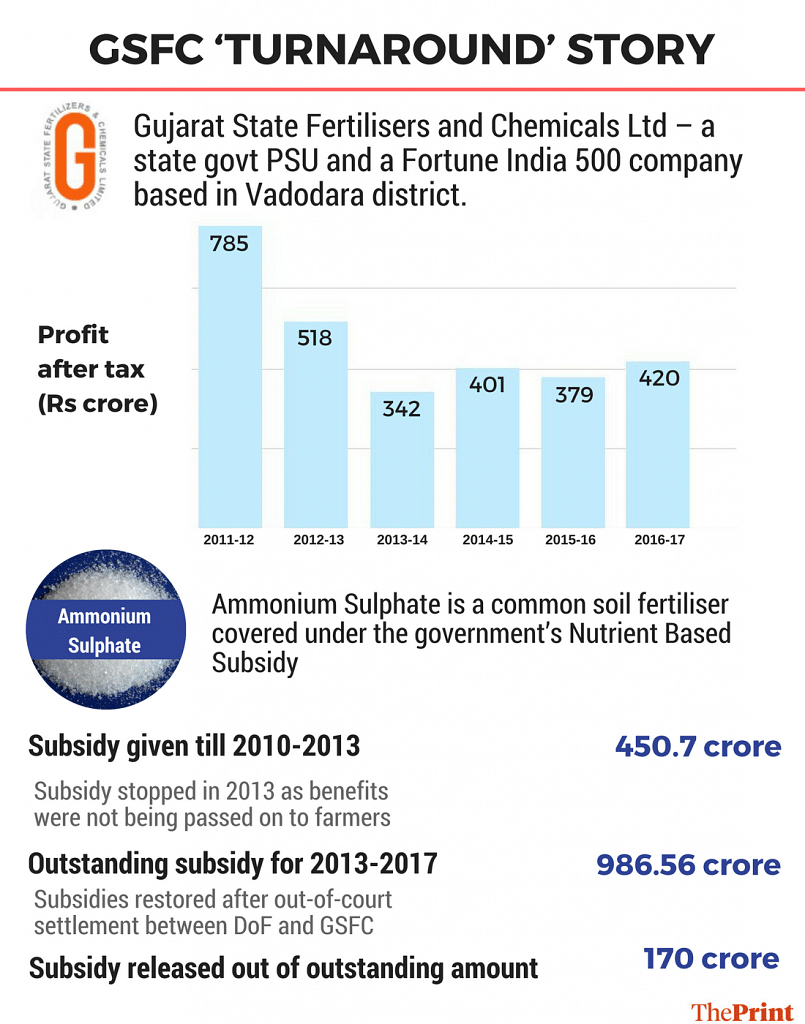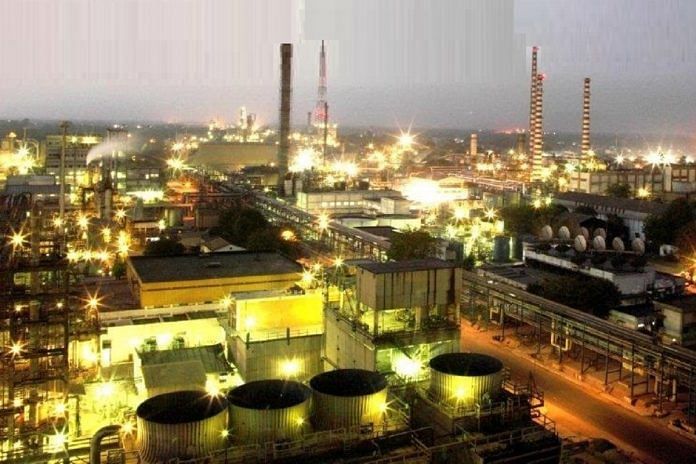UPA had stopped subsidy to GSFC in 2013 after it was found the company wasn’t passing it on to farmers but pocketing it. Modi govt reversed decision this March.
New Delhi: Gujarat State Fertilisers & Chemicals Ltd (GSFC), a crown jewel PSU of the state government and a shining example of an ailing government firm revived by Narendra Modi when he was chief minister, suffered a major embarrassment in 2013 when the Union fertilisers ministry withheld its share of a fertiliser subsidy “because it was held to be not passing it on to farmers but pocketing it to shore up its balance sheet”.
The Gujarat PSU rejected the charge and took the ministry to court.
Four years on, GSFC has found redemption, and not by winning the court case. The Centre made an “out-of-court settlement” with the company in March this year and agreed to resume the subsidy from that month itself.
More significantly, the central government is also actively considering paying GSFC the subsidy it withheld from 2013 to 2017.
The outstanding amount for these four years adds up to a neat Rs 986.56 crore – a lot for a company with revenues of Rs 5,477 crore and net profit of Rs 419.5 crore in fiscal 2016-17.
In fact, a part of that outstanding amount – Rs 170 crore – was also released in March.
The story, and the Centre’s turnaround, has gone unreported so far. ThePrint filed applications under the Right to Information (RTI) Act to access documents from the government.
So what changed to dramatically turn the fortunes of the company now?
For one, the subsidy was withdrawn by the UPA government of Prime Minister Manmohan Singh, and now Modi’s NDA is in power.
Second, this is the year of the assembly election in Gujarat, and the central government and a prized PSU in the prime minister’s home state cannot be seen in a legal stand-off and risk becoming a weapon in the hands of the opposition.
A listed, Fortune India 500 company, GSFC was set up in the 1960s to manufacture fertilisers. It is 38 per cent owned by Gujarat State Investments Ltd or GSIL, the investment arm of the state government.
Its turnaround from an ailing PSU in the early 2000s to one making consistent profits is credited to the leadership of Modi when he was chief minister of the state.
But GSFC took a hit on 18 March 2013 when an order from the Department of Fertilisers (DoF) discontinued the subsidy it was giving the company for ammonium sulphate.
It was a double hit, because the Centre also ordered recovery of all ammonium sulphate subsidy given to GSFC from 2010 to 2013, saying it had not passed on the benefit to farmers. The total amount: a further Rs 452.6 crore.
Ammonium sulphate is one of 22 fertilisers covered under the government’s nutrient-based subsidy (NBS) policy of 2009. A nitrogenous fertiliser, it is used for everything from paddy to lawns.
Responding to queries from ThePrint under the Right to Information Act, the DoF said GSFC had been given ammonium sulphate subsidy of Rs 144.8 crore in 2010-11, Rs 183.4 crore in 2011-12, Rs 122.5 crore in 2012-13, and Rs 1.9 crore in 2013-14 before it was stopped.
“In spite of getting subsidy under NBS policy, the MRP fixed by the company continued to remain at same level,” the March 2013 order had said.

The expectation obviously was that once the subsidy was paid, GSFC would bring down MRP accordingly, so it would be passed on to the farmer. The order noted this accordingly, with clarity.
“In other words, the subsidy paid by the government to M/s GSFC has not been passed on to the farmers by the company. This defeated the very purpose for which the subsidy is paid by the government,” it said.
“The GSFC has not provided data and justification to substantiate that subsidy paid by government has not resulted in undue gains to the company,” it added.
GSFC, however, countered the DoF and termed the move arbitrary and unfair. It argued that it sold the cheapest ammonium sulphate at Rs 7,500 a tonne in Gujarat, lower than that of Fertilisers and Chemicals Travancore Ltd (FACT) at Rs 11,013 a tonne.
GSFC challenged the DoF decision in the Delhi High Court, only to withdraw the petition after the two agreed to settle the issue outside court.
“The subsidy has been resumed with effect from 6.3.2017 vide OM dated 15.3.2017,” the department said in its RTI response. “The court case has been withdrawn by GSFC.”
The RTI responses reveal that GSFC had made a representation to DoF in April 2016, which was examined and then “decided with the approval of the competent authority to include the ammonium sulphate (caprolactam grade) manufactured by GSFC under NBS scheme w.e.f 06.03.2017 till further orders”.
Explaining the reason for the resumption of subsidy for ammonium sulphate to GSFC, DoF said it was stopped in 2013 on the basis of “queries regarding non passing of subsidy benefits to farmers (sic)” and because the company submitted its cost data “after much delay”.
The cost data documents, it said, were examined by the Director (Cost Evaluation), Fertiliser Industry Coordination Committee (FICC), a subordinate office of DoF, and the analysis was submitted to a committee of joint secretaries.
“Based on the analysis of FICC and recommendations of the joint secretaries committee, it was decided to allow subsidy on AS (ammonium sulphate) of GSFC w.e.f 06.03.2017,” it said, in effect hinting that this was just an issue of calculations.
The 2013 decision, it added, had not been “overturned” and an amount of Rs 33.78 crore was recovered from GSFC for the period of 2010-2013 “as the benefits were not passed on to farmers by the company”.
GSFC confirmed that subsidy for ammonium sulphate had resumed.
“Our ammonium sulphate fertiliser is considered under the nutrient based subsidy policy of the Government of India and accordingly, we are getting our subsidy payments on this fertilizer as per the NBS rate prevailing from time to time,” M.P. Punwar, manager for market research at GSFC, said in response to queries from ThePrint.
But, Srikant Jena, who was the UPA’s Union minister of state for chemicals and fertilisers with independent charge in 2013, expressed surprise at the change in the position of the government on the issue.
“The subsidy was withdrawn from GSFC because there was a blatant violation – it was not passed on to farmers. GSFC made a representation before us and they failed to explain the same,” Jena told ThePrint.
“The action was nowhere politically motivated as we had been rather liberal with GSFC, it being a state PSU. In fact, we also withdrew subsidy given to another Central PSU, Rashtriya Chemicals and Fertilisers, on similar grounds,” he said. “I am therefore very surprised that the same ministry which took a position and decision on a very sound basis has suddenly reversed it.”






